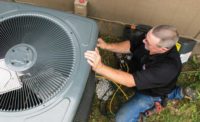Chris Nelson, vice president of sales and marketing, Carrier Residential and Commercial Systems, accurately summed it up by stating, “2011 had mixed results. We were encouraged to see volume up for the first time in a while, but product mix declined with the phaseout of the federal tax credit, as well as growth in the dry R-22 segment.”
Given these mixed signals, it is difficult to determine what to expect over the next year, although most manufacturers echo Gary Clark, senior vice president of marketing, Goodman Global Group Inc., who stated, “Overall, we see 2012 being very similar to 2011.”
Same to Slightly Better
Don Winter, vice president of marketing, McQuay International, agreed with this assessment, noting that the economy seems to be recovering very slowly. “Our manufacturer representatives anticipate another flat to slight increase in business in 2012. Retrofits will continue to be strong, comprising approximately 80 to 90 percent of the work. The health care and data center markets look promising, and there is an increase in demand for energy efficiency that we are seeing in most markets.”
There is a slight recovery in the housing market, stated Karl Zellmer, vice president of sales, Air Conditioning Business, Emerson Climate Technologies, with strength in multi-family units supporting growth. “Mix to lower cost products remains a trend, as average household incomes continue to suffer. High-end system sales are lower now than when a lot of incentives were in place; however, there is a market for these systems with homeowners concerned about energy savings and comfort.”
Another reason why the housing market has not bounced back is that homeowners cannot rely on their home’s equity like they used to, said Marc Zipfel, director of product marketing, Mitsubishi Electric Cooling and Heating. “Many homeowners are staying put and only replacing those items that must be fixed, rather than upgrading appliances that don’t necessarily need replacing.”
Many consumers also continue to repair rather than replace equipment, and this trend will probably continue into the near future, said Nelson, although he expects homeowners to move toward replacement as the economy gains strength. However, the popularity of R-22 dry-charge units is also leading more consumers to repair rather than replace entire systems, noted Zellmer.
The phaseout of the federal tax credit continues to affect the industry, as indicated by equipment sales shifting back toward minimum SEER and AFUE efficiency levels. The good news, noted Clark, is that awareness of high-efficiency HVAC options increased during the tax credit period, and as utility costs increase, homeowners will be reminded that high-efficiency products offer operational savings compared to standard efficiency systems.
David Meyers, vice president of sales, Carrier Residential Systems, agrees, noting that the tax credit gave contractors and manufacturers an opportunity to start a conversation with homeowners about higher efficiency products and their corresponding benefits. “We found out that people are very open to the idea of purchasing higher efficiency products that deliver improved comfort and cost savings while reducing environmental impact. With or without the tax credits, we expect homeowners to continue to be interested in this because the benefits are so compelling.”
Industry Issues
As noted previously, the demand for R-22 dry-charged units was strong in 2011, and Clark anticipates this trend will continue unless government guidelines are changed. Meyers added that the larger-than-expected market for R-22 units in 2011 was reflective of a tough economy in which consumers used lower-cost replacement alternatives when repairing equipment was not feasible.
The in-room air conditioning unit is one of those low-cost alternatives that consumers have purchased in large quantities over the past few years. “This is a disturbing trend, as these systems are less efficient and therefore more challenging to the power infrastructure,” said Zellmer.
As for the future of R-22 dry-charged units, Meyers noted that Carrier manufactured these units in line with market demand; however, the company filed a petition with the U.S. Environmental Protection Agency (EPA) in February 2011 to close the allowance that permits manufacturers to produce and ship uncharged R-22 air conditioning condensing units. “We are hopeful that the EPA will take steps toward regulations that are more in line with the intent of the phaseout. But until these steps are well defined and understood, we will continue to participate in this segment.”
One of the more controversial issues this year will be the Department of Energy’s (DOE) final rule establishing regional standards for air conditioners, heat pumps, and furnaces, which is scheduled to go into effect in 2013. The standard will divide the United States into three regions, and the minimum efficiency standards for residential HVAC appliances will vary depending on the region in which they are installed. Several industry groups are fighting this standard in court, while the Air Conditioning, Heating. Refrigeration Institute stands firmly behind DOE.
Carrier also supports the standard, noted Meyers, stating that one of the primary tenets of the DOE’s new regional efficiency standards is to reduce overall energy consumption and save consumers money on utility bills through the use of high-efficiency products. “I believe it is a step in the right direction for the industry. At Carrier, we’re going to continue doing all we can to help our distribution channel and our customers prepare for the new efficiency standards through the development of high-efficiency products.”
Zellmer has concerns about the standard, noting that historically, any regulated increase in minimum efficiency typically has resulted in higher costs, which have been passed on to the consumer and had the effect of dampening unitary market growth. “Higher prices also cause consumers to consider the use of other products like window units, which offer much less in the way of efficiency and comfort, or repair of an older, low efficiency system. It is important that the industry step up to the challenge of providing cost-effective new systems and also explain — as well as sell — the real benefits of higher efficiency, whole-house, unitary air conditioning solutions. Emerson Climate Technologies is actively engaged in the development of cost-effective new products that will support system manufacturers preparing to meet the new requirements.”
Texting and Tweeting
Social media and opinion-based websites have taken the HVAC industry by storm, and they will continue to substantially affect the buying patterns of consumers. That can be a help or a hindrance, noted Clark, as in the past, homeowners would have had to call friends and family members individually to get their opinions on HVAC service or replacement. “Today, homeowners can gather the thoughts and opinions of hundreds of people in just a few minutes by way of a wide variety of electronic communication tools.”
Zipfel noted that mobile devices are definitely having an impact on consumer buying behavior, which is why Mitsubishi has embraced smart phones and tablets as useful business tools. The company is also taking full advantage of social media such as Facebook, Twitter, and YouTube in order to create a two-way dialogue with all customer groups. “By establishing our brand through social media, we feel we are enabling the customer to make a more informed decision when they purchase our products.”
Mobile apps are also becoming very popular, especially on the jobsite, said Winter. “The Daikin McQuay Delivered VAV System can be viewed and accessed on an iPad or iPhone. We are also developing energy analysis mobile apps that will allow a contractor to easily provide a payback analysis for customers.”
Social media can provide a tremendous opportunity for contractors to educate consumers and drive service calls and sales, said Zellmer. “It can also result in well-educated consumers who have done online research and are, in some cases, ahead of the curve in demanding high-efficiency systems and improved comfort.”
Clark added that the pervasiveness of electronic communication and social media are starting to result in time compression in the HVAC industry, where “everyone wants the best possible solution in the shortest amount of time. Dealers, in particular, need to examine their business structure to make certain that they are taking advantage — and capturing — marketing opportunities in tandem with the advances that homeowners are making.”
Consumers are, indeed, becoming more demanding and better educated, said Meyers, and they want to better understand the equipment they are buying. “I view this as an opportunity to start conversations with consumers about higher-efficiency products, indoor air quality solutions, and other product and service offerings.”
Demanding customers, slow economic recovery, more regulation, uncertainty over R-22 units — looks like 2012 is shaping up to be an interesting year in the HVAC industry.
Publication date: 03/12/2012












